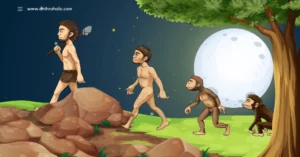AI Answer Evaluation Platform Live Now. Try Free Answer Evaluation Now
Era
An era is a distinct period of history marked by particular events, characteristics, or individuals. It’s a way of dividing time that extends beyond years or centuries, grouping together substantial periods of human history, or long spans of geological or cosmic time [1].

Characteristics of an Era
Some defining characteristics of an era include:
- Distinct cultural, technological, or social changes.
- Significant events or individuals that define the period.
- Shared global or regional experiences.
Types of Eras
Eras are found across multiple disciplines, from geology to history. Some well-known types are:
Geological Eras
The geological time scale divides the Earth’s history into eons, eras, periods, epochs, and ages. These divisions are based on significant events in the Earth’s history, like the appearance or disappearance of certain life forms, or dramatic shifts in the planet’s climate. The three primary geological eras of the Phanerozoic Eon are:
| Geological Era | Years Ago |
|---|---|
| Paleozoic Era | 541 to 252 million years ago |
| Mesozoic Era | 252 to 66 million years ago |
| Cenozoic Era | 66 million years ago to present |
Each era reflects a different stage in the development of life on Earth [2].
Historical Eras
In historical terms, eras signify key periods recognized for their distinct cultural, technological, political, or social shifts. Some examples include:
- Ancient Era: From the beginning of recorded history until the Middle Ages.
- Medieval Era: Also known as the Middle Ages, from the 5th to the 15th century.
- Modern Era: From the 15th century to the present, further divided into the Early Modern and Late Modern periods [3].
Significance of Eras
Eras are not just simple categorizations of time; they serve several important functions.
- Understanding Progression: Eras help us comprehend the progression of events, ideas, or life forms over time. They act as markers in the timeline, allowing us to make sense of the past and its influence on the present and future.
- Comparative Analysis: By dividing time into eras, we can compare different periods more effectively. For example, the Industrial Revolution significantly distinguishes the modern era from the medieval era in terms of technological advancements [4].
- Educational Framework: Eras also provide a framework for education. They serve as a tool for organizing lessons in a coherent and chronological manner, allowing for better comprehension and retention of information.
Controversies and Limitations
While eras are useful, they are not without controversy or limitations.
Eurocentrism
Historical eras often suffer from a Eurocentric bias, meaning they mainly focus on Western history. Such views can skew our understanding of global events and marginalize the histories of non-Western civilizations [5].
Arbitrariness of Boundaries
The boundaries of an era can sometimes be arbitrary. The transitions are not always clear-cut and may vary based on different perspectives.
Eras in Pop Culture
In addition to geology and history, the term ‘era’ is also used in the realm of pop culture, denoting distinctive periods within music, fashion, and entertainment.
A. Music
In music, eras often delineate shifts in style, technology, or dominant genres. For example, the ‘Big Band Era’ (1935-1945) was dominated by jazz and swing music. Artists, too, have their own eras defined by stylistic changes, image transformations, or different album cycles. Pop star Madonna, for instance, is known for the numerous ‘eras’ in her career, each reflecting different musical styles and aesthetic choices [6].
B. Fashion
Fashion eras signify periods characterized by distinctive clothing styles, often reflecting broader cultural and societal changes. For example, the ‘Roaring Twenties’ introduced shorter hemlines and less restrictive clothing for women, reflecting newfound freedoms and rebellious attitudes of the period [7].
The Concept of ‘Era’ in Sports
In sports, eras often delineate periods dominated by specific teams, athletes, or significant changes in rules or playing styles. Examples include the ‘Bulls Era’ in the NBA, when the Chicago Bulls dominated under the leadership of Michael Jordan in the 1990s, and the ‘Dead-Ball Era’ in Major League Baseball, a period in the early 20th century when home runs were rare and low-scoring games were the norm [8].
Future Perspectives
While the concept of an era has proven beneficial across various disciplines, it’s vital to remain critical of how we delineate these periods. As we continue to evolve and learn more about our world and its history, our understanding of what constitutes an era will likely become more nuanced and inclusive, reflecting the diverse experiences and perspectives of our global society.
Conclusion
Understanding the concept of an era can provide valuable insights into the passage of time, revealing patterns and shifts in our shared experiences across multiple disciplines. Despite their limitations and the occasional controversies they spark, eras remain a central component of our understanding of time and progress.
References
[1] “Era.” Merriam-Webster. https://www.merriam-webster.com/dictionary/era (accessed July 20, 2023).
[2] “Geological Time Scale.” United States Geological Survey. https://www.usgs.gov/faqs/what-are-geologic-units-geologic-time-scale?qt-news_science_products=0#qt-news_science_products (accessed July 21, 2023).
[3] “Historical Period.” Encyclopaedia Britannica. https://www.britannica.com/topic/history (accessed July 21, 2023).
[4] Landes, David S. “The Industrial Revolution.” Encyclopaedia Britannica. https://www.britannica.com/event/Industrial-Revolution (accessed July 22, 2023).
[5] Galtung, Johan. “Eurocentrism: Its Origins and Consequences.” The Journal of Peace Research, vol. 20, no. 4, 1983, pp. 335-346.
[6] Savage, Mark. “Why do pop stars change their image for each album?” BBC News. https://www.bbc.com/news/entertainment-arts-39692024 (accessed July 22, 2023).
[7] Carter, Ernestine. “History of fashion design – Women’s dress, 1900–39.” Encyclopaedia Britannica. https://www.britannica.com/art/fashion-design/The-20th-century (accessed July 22, 2023).
[8] “Baseball – The Deadball Era.” Encyclopaedia Britannica. https://www.britannica.com/sports/baseball (accessed July 22, 2023).




